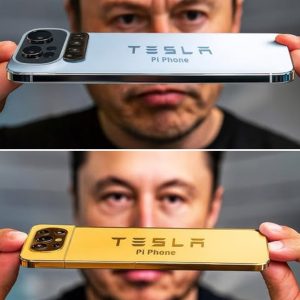Elon Musk’s 2026 Tesla Tiny House Revealed, The Innovation That’s About to Change Everything!
Elon Musk has just unveiled the Tesla Tiny House 2026, a futuristic creation designed to revolutionize how the world lives, compact, sustainable, and entirely powered by Tesla technology. Built with solar energy, AI climate control, and self-sufficient water recycling, this isn’t just a house, it’s a glimpse into humanity’s off-grid future.
Early reviewers are calling it “a home that thinks for you,” while investors say it could upend the entire real estate market overnight. But it’s Musk’s final statement that has everyone talking, a cryptic promise that “this house will outlast every storm.”
What did he mean by that? The answer might just redefine the meaning of home.
Elon Musk has done it again. Just when the world thought Tesla had reached its innovation peak with electric vehicles, solar roofs, and humanoid robots, Musk unveiled his next big disruption — and this time, it’s aimed directly at how we live.
The Tesla Tiny House 2026 isn’t just another futuristic design experiment; it’s a full-blown declaration of intent to revolutionize sustainable living. Combining solar energy, AI-powered systems, and materials lighter than aluminum, the new Tesla home promises to redefine off-grid independence — and in Musk’s words, “make housing as smart, efficient, and mobile as our cars.”

From EVs to Living Spaces: Musk’s Next Great Leap
During a highly anticipated reveal streamed live from the Tesla Design Center in Texas, Musk introduced what he called “the next logical step in human autonomy.”
Standing in front of a sleek, minimalist structure no larger than 400 square feet, Musk described the 2026 Tesla Tiny House as “a fully self-sustaining, zero-emission dwelling that anyone can afford, move, and manage with the tap of a button.”
The announcement stunned investors and consumers alike. Within hours, the hashtag #TeslaTinyHouse was trending globally, with analysts speculating that Tesla might not just be entering the housing market — it might be reinventing it altogether.
What Makes the Tesla Tiny House Different
At first glance, the house looks like something straight out of a sci-fi movie: an elegant, compact structure with smooth lines, solar-paneled surfaces, and Tesla’s signature matte-steel finish. But the real magic is inside.
According to Tesla’s release, the 2026 model includes:
- SolarSkin 3.0 Panels — an ultra-efficient solar coating developed from the same technology powering SpaceX satellites, capable of generating up to 30% more energy than traditional panels.
- Powerwall 5 Integration — a next-generation Tesla battery system that stores energy for up to 10 days of continuous off-grid operation.
- Tesla SmartCore AI — a fully autonomous home management system that regulates temperature, lighting, and energy use based on the owner’s habits, even syncing with their Tesla vehicle.
- Recyclable NanoSteel Frame — a lightweight, rustproof, impact-resistant structure designed to last more than 100 years with minimal maintenance.
Musk compared the innovation to Tesla’s car revolution: “When we made the Model 3 affordable, it democratized electric mobility. The Tesla Tiny House will do the same for sustainable living.”
Affordable, Portable, and 100% Off-Grid
Perhaps the most shocking part of the announcement wasn’t the design — it was the price. Musk confirmed that the base model of the Tesla Tiny House will retail for $7,575 — yes, less than the cost of some used sedans.
That number sent shockwaves through the construction and housing industries, where affordability has been the biggest barrier to sustainability.
Musk explained that Tesla’s vertical manufacturing model, combined with modular design and recycled materials from the company’s Gigafactories, allows for massive cost reductions. “We’re building homes like we build cars,” he said. “Fast, efficient, and scalable.”
Each unit is delivered fully assembled, transported via Tesla Semi, and can be set up in less than one hour — no foundation required. Power comes from the roof’s solar skin and Powerwall system, while water filtration and composting systems allow for fully off-grid operation.
The home can even be moved, self-contained, to a new location — powered by a Tesla Cybertruck towing it with zero emissions.

Inside the Tesla Lifestyle
Stepping inside, the design philosophy becomes clear: luxury through simplicity.
A panoramic smart glass window dominates the front wall, automatically adjusting its tint to optimize light and temperature. The living area includes modular furniture that transforms into a workspace, dining set, or bed. Every appliance — from the induction stove to the entertainment hub — runs on Tesla’s AI-managed energy ecosystem.
Voice-activated controls respond to the same AI system that powers Tesla vehicles. A single voice command — “Hey Tesla, I’m home” — triggers a symphony of automation: climate adjustment, ambient lighting, and background music calibrated to the user’s mood data gathered from wearable devices.
Even the bathroom features hydrogen-recycling showers designed to use 90% less water than traditional ones.
Musk described it as “living in the world’s most efficient spaceship, only it’s on Earth.”
A Solution for the Housing Crisis?
Analysts see the Tesla Tiny House as more than a luxury novelty — it could represent a seismic shift in how Americans think about home ownership. With housing prices skyrocketing and urban populations surging, Musk’s modular design offers an entirely new model for affordability.
“The Tesla Tiny House could do for housing what the iPhone did for communication,” said tech analyst Morgan Lathrop. “It redefines what’s possible — not by adding more, but by using technology to make less feel like more.”
Several U.S. states, including Texas, Nevada, and Arizona, have already expressed interest in pilot programs to use Tesla’s modular homes in sustainable community projects. Nonprofits are also exploring partnerships to deploy them as affordable housing for veterans and low-income families.
Critics Raise Questions
Of course, not everyone is convinced. Skeptics argue that Musk’s $7,575 price tag may be unrealistic once regulatory, land, and delivery costs are factored in. Others warn that the “off-grid dream” could appeal mostly to the wealthy and tech-savvy, not those struggling most with housing insecurity.
Environmental activists, while impressed with the technology, have also urged caution. “Musk is an innovator, but innovation doesn’t automatically equal accessibility,” said Carla Dominguez of the Green Planet Foundation. “If Tesla truly wants to democratize sustainable living, they’ll need to ensure these homes aren’t just for the Instagram crowd.”
Still, the excitement is undeniable. Within 48 hours of the announcement, Tesla’s website crashed due to overwhelming traffic from pre-order inquiries.

Tesla’s Ecosystem Expands
The tiny house isn’t a standalone project — it’s another piece of Tesla’s grand ecosystem. Owners will be able to sync their homes with Tesla’s SolarCity grids, Powerwall batteries, and vehicle-to-home (V2H) systems.
That means your car could literally power your house. When connected to a Tesla vehicle, energy can flow bidirectionally, letting owners charge their homes during outages or sell unused energy back to the grid.
“It’s not just a house,” Musk said. “It’s an energy node — part of a living network that makes every Tesla owner a producer, not just a consumer.”
The Road Ahead: 2026 and Beyond
Production of the Tesla Tiny House will begin in early 2026, with preorders opening in spring 2025. Tesla’s Nevada Gigafactory will handle the initial manufacturing, with additional facilities planned in Texas and Berlin.
Early prototypes will be displayed in Tesla showrooms alongside vehicles, giving customers a hands-on experience of what Musk calls “the Tesla lifestyle.”
Musk also hinted at a larger version — a “Tesla MicroVilla” — currently in development for families or small communities, built using the same energy ecosystem.
“This is just the beginning,” he teased at the end of the event. “We started with cars. Now, we’re building the world that goes with them.”
A New Vision of Home
Whether you admire Musk or doubt him, it’s hard to deny his ability to reimagine the ordinary. Cars, rockets, satellites — and now, homes.
The Tesla Tiny House 2026 represents more than just another product launch. It’s a manifesto for how technology, design, and sustainability can converge into something profoundly human: freedom.
Freedom from rent, from grids, from environmental guilt — and maybe even from the idea that a “home” has to be a permanent address.
As the livestream ended, Musk left the audience with one final thought:
“If your home can move with you, power itself, and never pollute — then maybe, for the first time, we’ve made true independence possible.”
With that, the future of living looked just a little smaller — and infinitely smarter.


